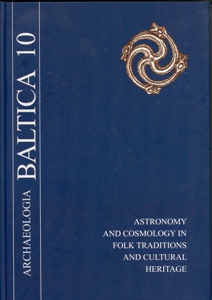Volume 10 (2008): Astronomy and Cosmology in Folk Traditions and Cultural Heritage, December 2008

Order by:
Pub. online: 20 Dec 2008
Type: Article
 Open Access
Open Access
Journal:
Archaeologia Baltica
Volume 10 (2008): Astronomy and Cosmology in Folk Traditions and Cultural Heritage, pp. 241–245
Abstract
Pub. online: 20 Dec 2008
Type: Article
 Open Access
Open Access
Journal:
Archaeologia Baltica
Volume 10 (2008): Astronomy and Cosmology in Folk Traditions and Cultural Heritage, pp. 246–252
Abstract
Pub. online: 20 Dec 2008
Type: Article
 Open Access
Open Access
Journal:
Archaeologia Baltica
Volume 10 (2008): Astronomy and Cosmology in Folk Traditions and Cultural Heritage, pp. 253–257
Abstract
Pub. online: 20 Dec 2008
Type: Article
 Open Access
Open Access
Journal:
Archaeologia Baltica
Volume 10 (2008): Astronomy and Cosmology in Folk Traditions and Cultural Heritage, pp. 258–262
Abstract
Pub. online: 20 Dec 2008
Type: Article
 Open Access
Open Access
Journal:
Archaeologia Baltica
Volume 10 (2008): Astronomy and Cosmology in Folk Traditions and Cultural Heritage, pp. 263–267
Abstract
Pub. online: 20 Dec 2008
Type: Article
 Open Access
Open Access
Journal:
Archaeologia Baltica
Volume 10 (2008): Astronomy and Cosmology in Folk Traditions and Cultural Heritage, pp. 268–272
Abstract
Pub. online: 20 Dec 2008
Type: In Memoriam
 Open Access
Open Access
Journal:
Archaeologia Baltica
Volume 10 (2008): Astronomy and Cosmology in Folk Traditions and Cultural Heritage, pp. 273–274
Pub. online: 20 Dec 2008
Type: Plates
 Open Access
Open Access
Journal:
Archaeologia Baltica
Volume 10 (2008): Astronomy and Cosmology in Folk Traditions and Cultural Heritage, p. 275